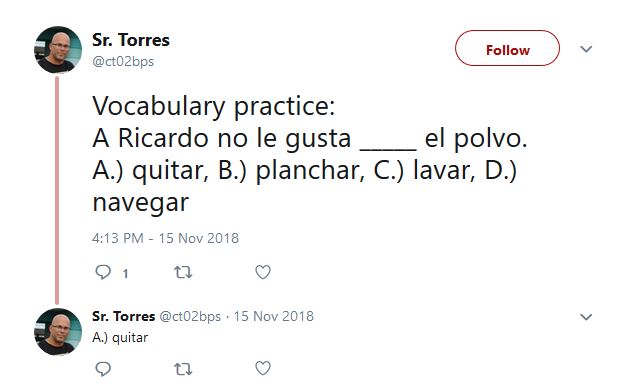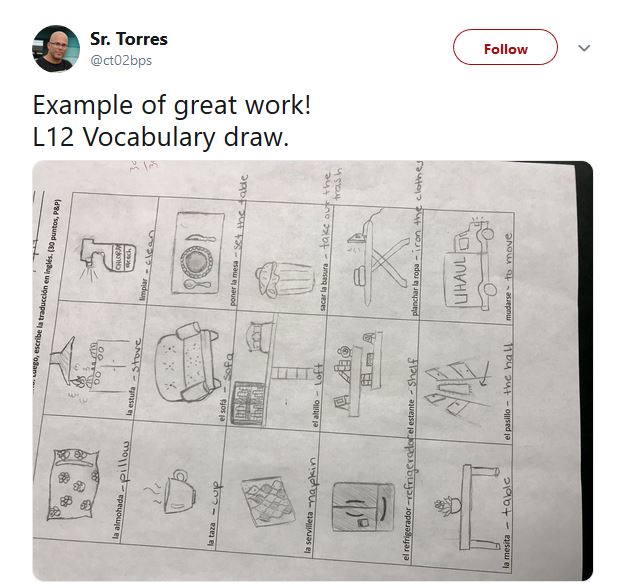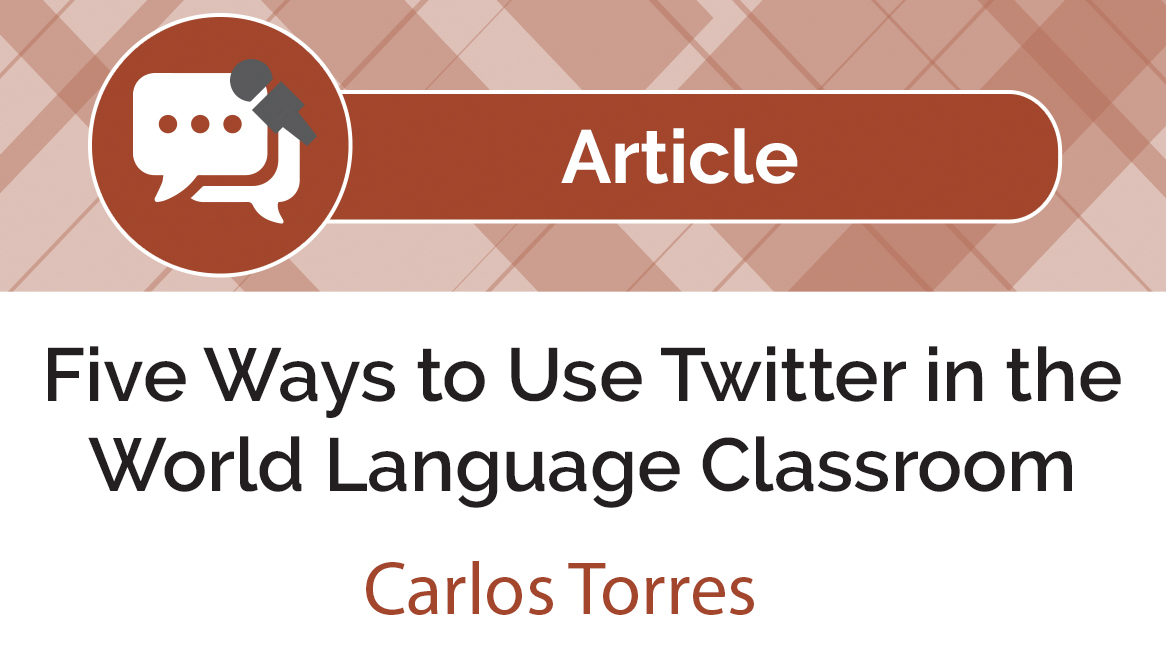Five Ways to Use Twitter in the World Language Classroom
 by Carlos Torres, Spanish teacher and department Head in Birmingham, MI.
by Carlos Torres, Spanish teacher and department Head in Birmingham, MI.
I am fortunate to work in a school district where the use of social media for instructional and extracurricular purposes is relatively commonplace. Teachers, sponsors, and coaches use multiple platforms and strategies to reach their students, club members, and athletes, as well as to communicate with parents and community members. It’s not uncommon to see photos of the latest robotics tournament, videos of the musical, or highlights of the game against our cross-town rival. But the most impressive work in our district when it comes to social media is what happens in the classroom. Our teachers tend to be technologically savvy, and they use their comfort and skills with social media to connect students with the content area on a deeper level. Of course, some teachers are more comfortable with technology and social media than others, but overall, we tend to be on the early-adopter side of the technology-in-schools continuum.
The following are five ways in which I use social media in the world-language classroom. More specifically, below you will find a few of the ways in which I incorporate Twitter into my Spanish 3 courses at the high-school level.
#1 – Announcements and reminders
We are in the trimester system, which means that students have 5 classes per day, for twelve weeks, before they switch classes. This means that there is a lot to learn in a relatively short period of time. When we consider that our students are going through a lightning-fast pace in all 5 of their courses, it’s understandable if they forget a deadline or two. So, in order to help students keep tabs on their upcoming assignments and assessments, I use Twitter as way to remind them about deadlines and upcoming activities. I also make announcements, like the plans for the next day, requests to bring the textbook to class for a particular lesson or activity, and the change in plans because of snow days, for example. Of course, when these announcements and reminders are posted, I am not only thinking of the students. I am posting this information for the parents, as well. Many parents do follow the class on Twitter, so they see the same information as the students, which has helped in addressing the needs of individual students, as all parties are informed about what is happening in class.

#2 – Practice for upcoming assessments
There are two types of assessments that take place in my Spanish class: micro-assessments and macro-assessments. Micro-assessments typically assess a vocabulary list or a single grammar concept, similar to a short quiz. But macro-assessments normally consist of reading and listening comprehension, vocabulary, and three or four grammar topics, akin to a unit exam. I use Twitter as a way to provide practice during the days leading to macro-assessments, by providing sample test items, as well as study tips. For example, if the assessment includes the present subjunctive, I will send a tweet with a sample sentence, but with a blank in the place where the verbs need to be used. In the tweet, at the end of the sentences I will include the verb in the infinitive. A few minutes after the tweet has been sent, I provide the correct answer (present indicative or infinitive) in the form of a comment on the same tweet. This gives students who follow the Twitter feed and receive notifications an opportunity to quiz themselves in real time. Students who do not have a Twitter account can go to my school website and follow along with the embedded stream. Either way, students have a chance to practice before the test, as well as to receive tips and hints that help them prepare for the assessment.

#3 – Student praise, Samples of quality work
There is great power in positive reinforcement, especially when learning a new language. When the class has done a great job in a particular task or when I feel that they are working extra hard, I reward them with praise on Twitter. It can be a simple tweet, like “Great job today,” or “Thanks for all your hard work,” but it lets them know that I notice their efforts. I ask permission first before I do the following, but when a student’s work is above and beyond the expectation, I post a photo of their work on Twitter (while avoiding their name from appearing on the image). Their faces shine when I ask them at the end of the class period if they mind if I post a picture of their assignment, and they are quick to share the news with their parents. The most common activity that I post is the vocabulary draw sheet, which is the first activity of a new chapter, where students translate the new words and make corresponding drawings. In both cases, students understand that I am paying attention and rewarding their efforts and attention to detail, and feel that their hard work is being recognized. For the students who provided the work, this is a great motivator to keep the high-quality work flowing, while for the other students, it serves as an example of good work.

#4 – Links to class materials and work
I must confess that I barely use the textbook in my classes. We have a curriculum that is pretty much based on a particular textbook series. But my view of the textbook is that it should be a resource for learning, not as a primary source. As a result of this view, even though I do strictly follow our curriculum, I create the vast majority of the materials we use in class. This means using a number of outside resources, like Google Classroom – classroom.google.com and Seesaw – seesaw.com. I also provide authentic readings and videos, in addition to the readings and listening exercises provided by the book publishers. But when one of our assignments includes an outside resource, I make sure to tweet the direct URL to the particular activity. This can be a link to a newspaper article, a YouTube video, a practice exercise in the Google Classroom, a video they need to create in Seesaw, etc. Because our staff, as mentioned above, is very technologically savvy, our students have a plethora of websites to remember and use throughout their day. In order to facilitate their access to the resources in my class, I take the extra step of directing them via Twitter to exactly where they need to go. It only takes a few extra seconds of preparation, but the reward is exponentially fewer students who could not “find” the activity online.

#5 – Taking an activity to the next level
One of my favorite class activities involves students walking around the school and taking pictures of the building. The pictures are supposed to include some sort of flaw that they would like to see the school administrators fix. I ask them to use the formal commands to tell the administration what to do to make the building more appealing. For example, they can take a picture of the gym, and ask the administrators to paint the gym doors. The activity can be taken to the next level by posting the photos to Twitter and adding a hashtag particular to their class period. We can then view all contributions at the end of class, by clicking on the hashtag. This activity is done in groups, in order to address equity issues, such as not all students owning a cell phone, not all students having parental permission to have a Twitter account, etc. By working in groups, all students have a role in the activity, even if they do not own a device or are not allowed to post on Twitter. Because students are engaged with both, the language and the technology, their learning of formal commands has greater potential to be permanent, as it is a real-world activity.
I consider myself to be a relatively early adopter of technology, especially when it comes to leveraging new tools to help students learn. Learning a new language is inherently a social activity, so incorporating social media seems to be the perfect fit. Students are able to stay up to date with class events, they can practice and receive hints on upcoming assessments, they feel valued as their hard work is recognized, they have a direct path to their work, and they can leverage technology to augment their learning. I cannot wait to read your ideas on how to incorporate Twitter into the world-language classroom.


What an insightful and innovative article! “Five Ways to Use Twitter in the World Language Classroom” provides an excellent and creative approach to incorporating technology and social media into language learning. The suggested methods are not only engaging but also foster authentic interactions and cultural immersion, making language learning a fun and meaningful experience for students. Embracing Twitter as a learning tool opens up a world of possibilities for language educators and their students, creating a dynamic and interactive learning environment.